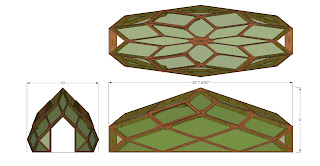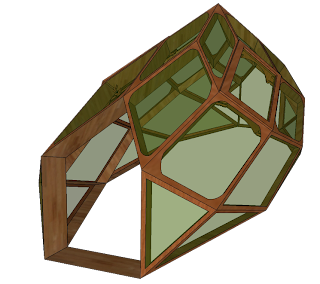The 2009 Metropolis Magazine Next Generation Design Competition Challenges Designers to Fix Our Energy Addiction. So we decided to enter our design. Here is the proposal:



Part I
Personal Information
First Name: Patricia
Last Name: Algara
City: Berkeley
Postal Code: 94703
Country: United States of America
Telephone: 415-509-3728
E-Mail: patriciaalgara@yahoo.com
Collaborator #1
First Name: Robert
Last Name: Bell
Firm/Department: Zomadic, LLC
Telephone: 415-407-6793
E-Mail: rob@zomadic.com
• • •
Part II
Your Proposal
What is the title of your proposal?
Urban Foodscaping : A Greenhouse Garden Zome
How would you describe it?
Our design is an integral first step in facilitating the change in consciousness to end our energy addition by addressing the second largest energy consumption sector; The production and transportation of food. To facilitate a shift to an urbanized agrarian society we present a community based, elegant food production solution.
How does it pertain to energy?
Growing locally reduces or eliminates the fuel needed to transport food to one’s table. It eliminates the energy used to produce the packaging and eliminates these materials from the waste stream. It eliminates the use of fertilizers and pesticides. And by harnessing the Sun’s energy one extends the growing season.
What makes it important?
The Problem: There’s a pressing need for Design Science to create an accessible, sustainable, local, organic food production solution. Why? The United State US California Moscow Havana US US US
How do the photos or renderings illustrate the concept?
The Garden Zome is the manifestation of a knock-down, modular, prefab building pattern. Material usage is minimized by distributing the compressive and tensile forces across a zonohedral spaceframe. Produced with CNC technology the Garden Zome is the fruition of an inexpensive, locally manufactured, easy to assemble, extensible and re-deployable shelter. What is a Zome? Zome is a combination of the words zonohedron and dome. A Zome is somewhat similar to a geodesic dome. However the structure of a Zome is based upon a class of polyhedron known as zonohedra. While a dome will tend to resemble a sphere a Zome will resemble a jewel. While providing a strong and lightweight building pattern Zomes have a natural organic aesthetic which is evident in the natural world. Zomes suffer from none of these issues and are more intrinsically natural and beautiful than geodesic domes. The simplicity and sublime nature of Zome geometry becomes apparent and it is through this symbolism of form that Garden Zomes provide a practical demonstration of an emergence of a collective consciousness, reminding each of us of the necessity to align ourselves with nature. In the following photos we demonstrate the results of a zonohedral spaceframe manufacturing and assembly system in which the convergent plurality of strut members are conjoined at each vertex with a radially concentric double gusset. Once each of the diamond shaped frames has been completed the panel frames can be snapped into place. Materials can be modified by location. Any structural grade exterior sheet goods may be appropriate for the framing and paneling structure. Producing the requisite parts in any local CNC shop requires that the parts be of high quality while the process be simple, well defined and foolproof. Every panel, gusset and frame member is highly modular and can be used in different structures or even in different configurations or additions to the same structure. A small scale functional prototype has been produced. Great pains were taken in designing and testing the joinery and assembly system such that no tools be required to build the structure. Everything snaps together much like a giant toy and yet is as light and strong as any conventional structure. This creates opportunity for a communal Garden Zome raising event in which all community members are able to lend a hand and engender feelings of ownership with the garden. Design attention has also been paid to the collection of rain water. The structural form of the Zome creates an excellent opportunity to channel water down the entire structure to be collecting into solar heated containers within the Garden Zome. This water can be used for irrigation and also acts an a heat capacitor to reduce the amount of energy required to keep the Garden Zome warm through the night. The final illustrations represent one Garden Zome design in plan, elevation and orthogonal view. We’ve also composed illustrations of the structure in various urban locations.
What is your business plan for realizing your proposal?
The Garden Zome (GZ) is not only an innovative product but we see it as a first step towards a much larger society cultural shift in consciousness to achieve energy reduction through local food production; it also establish food justice by establishing food systems and economy, making healthy food accessible as a basic human right. It creates a space where experiences can happen. Since our model is based on sharing and building we will provide ready to fabricate GZ designs released with a creative commons license on open source design software and 3d model repositories such that any person can have access to download, customize and have locally manufactured GZ. Thru Creative Commons licensing GZ digital fabrication files will be made available to a community. Additionally design and build expertise will be given to help find local fabricators or to produce the kits. We have two target groups with different needs and solutions: i) Urban dwellers in densely populated areas Urban dwellers often feel disconnected from nature and desire to have a closer connection to their food production. Rooftops provide an excellent source of space to grow food. Green roofs offer other multiple benefits: they help clean the air, limit noise and dust, and greatly reduce heat-island effect. Our GZ also captures rain water, thus reducing run off into the city water systems. China Beijing Richmond Richmond and West Oakland have enormous latent potential in the form of vacant lots which can be transformed into urban farms thus providing training, jobs, activities and nutritiously rich local grown food to its residents. The garden zome may be manufactured locally with recycled materials thus providing more green jobs for green infrastructure













